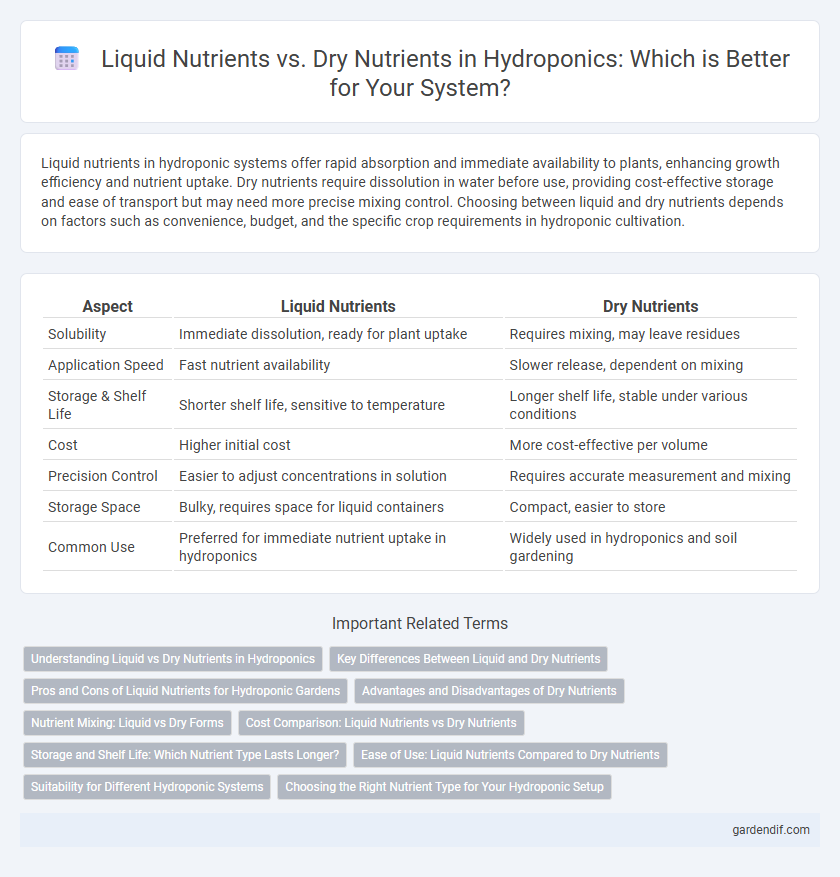
Liquid nutrients vs Dry nutrients Illustration
Liquid nutrients in hydroponic systems offer rapid absorption and immediate availability to plants, enhancing growth efficiency and nutrient uptake. Dry nutrients require dissolution in water before use, providing cost-effective storage and ease of transport but may need more precise mixing control. Choosing between liquid and dry nutrients depends on factors such as convenience, budget, and the specific crop requirements in hydroponic cultivation.
Table of Comparison
| Aspect | Liquid Nutrients | Dry Nutrients |
|---|---|---|
| Solubility | Immediate dissolution, ready for plant uptake | Requires mixing, may leave residues |
| Application Speed | Fast nutrient availability | Slower release, dependent on mixing |
| Storage & Shelf Life | Shorter shelf life, sensitive to temperature | Longer shelf life, stable under various conditions |
| Cost | Higher initial cost | More cost-effective per volume |
| Precision Control | Easier to adjust concentrations in solution | Requires accurate measurement and mixing |
| Storage Space | Bulky, requires space for liquid containers | Compact, easier to store |
| Common Use | Preferred for immediate nutrient uptake in hydroponics | Widely used in hydroponics and soil gardening |
Understanding Liquid vs Dry Nutrients in Hydroponics
Liquid nutrients in hydroponics provide immediate availability and uniform distribution of essential minerals, ensuring rapid plant uptake and growth. Dry nutrients, often in powdered or granular form, offer cost-effectiveness and longer shelf life but require precise dilution to avoid nutrient imbalances or deficiencies. Selecting between liquid and dry nutrients depends on factors such as plant species, growth stage, system type, and grower convenience for optimizing hydroponic nutrient management.
Key Differences Between Liquid and Dry Nutrients
Liquid nutrients offer immediate availability and faster absorption for hydroponic plants, while dry nutrients require dissolving in water before use. Liquid formulations provide consistent nutrient delivery and are easier to adjust for precise growth stages, whereas dry nutrients are cost-effective and have longer shelf life. The choice between liquid and dry nutrients depends on factors like ease of use, storage, and specific crop nutritional needs.
Pros and Cons of Liquid Nutrients for Hydroponic Gardens
Liquid nutrients for hydroponic gardens offer rapid nutrient absorption and easy adjustability of feeding schedules, promoting faster plant growth and immediate correction of deficiencies. These nutrients provide uniform distribution, reducing the risk of nutrient imbalances, but they require more frequent monitoring and can degrade faster than dry alternatives, potentially increasing cost and handling effort. Their high solubility ensures efficient uptake, yet storage challenges and susceptibility to microbial contamination pose practical drawbacks for long-term use.
Advantages and Disadvantages of Dry Nutrients
Dry nutrients offer precise control over nutrient concentrations and longer shelf life compared to liquid forms, making them cost-effective for large-scale hydroponic systems. They require careful mixing to avoid nutrient imbalances and may dissolve unevenly, potentially leading to inconsistent plant growth. Storage and handling are easier with dry nutrients, but they demand more preparation time before application in hydroponic solutions.
Nutrient Mixing: Liquid vs Dry Forms
Liquid nutrients offer precise and rapid nutrient availability, dissolving instantly in water for uniform distribution in hydroponic systems. Dry nutrients require thorough mixing and dissolution, potentially leading to uneven concentration and longer preparation times. Optimizing nutrient mixing ensures balanced plant growth and maximizes hydroponic system efficiency.
Cost Comparison: Liquid Nutrients vs Dry Nutrients
Liquid nutrients typically have a higher initial cost than dry nutrients due to their convenience and immediate availability for plant absorption in hydroponic systems. Dry nutrients are more cost-effective per dose and have a longer shelf life, making them economical for large-scale or long-term hydroponic cultivation. Choosing between liquid and dry nutrients depends on budget constraints and desired efficiency in nutrient delivery.
Storage and Shelf Life: Which Nutrient Type Lasts Longer?
Liquid nutrients tend to have a shorter shelf life, typically lasting six to twelve months due to their susceptibility to microbial growth and chemical degradation. Dry nutrients, when stored in a cool, dry environment, can remain stable for several years without losing potency. Proper storage conditions, such as airtight containers and controlled humidity, significantly extend the longevity of dry hydroponic nutrients compared to liquid formulations.
Ease of Use: Liquid Nutrients Compared to Dry Nutrients
Liquid nutrients offer superior ease of use compared to dry nutrients due to their immediate solubility and uniform distribution in hydroponic systems. They require no prior mixing or dissolution, minimizing preparation time and reducing the risk of inconsistent nutrient delivery. This convenience is especially beneficial for maintaining precise nutrient balances in fast-paced hydroponic farming environments.
Suitability for Different Hydroponic Systems
Liquid nutrients offer rapid absorption and precise control, making them highly suitable for recirculating hydroponic systems like NFT (Nutrient Film Technique) and DWC (Deep Water Culture). Dry nutrients are cost-effective and easier to store, preferred in non-recirculating or drip irrigation systems where gradual nutrient release is beneficial. The choice between liquid and dry formulations depends on system type, nutrient delivery efficiency, and crop requirements in hydroponic setups.
Choosing the Right Nutrient Type for Your Hydroponic Setup
Choosing the right nutrient type for your hydroponic setup depends on factors such as ease of use, storage, and plant growth stages. Liquid nutrients offer immediate availability and quick absorption, ideal for rapid growth cycles, while dry nutrients are cost-effective, have a longer shelf life, and provide customizable formulations. Balancing pH levels and nutrient concentration is essential regardless of the chosen form to ensure optimal plant health and maximum yield in hydroponic systems.
Liquid nutrients vs Dry nutrients Infographic

 gardendif.com
gardendif.com